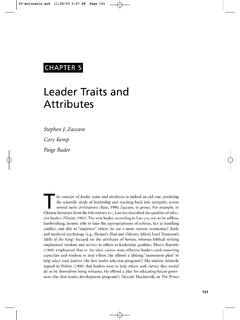Transcription of The Hacienda de Calamba Agrarian Problem (1887-1891): A ...
1 The Hacienda de Calamba Agrarian Problem (1887-1891): A Historical assessment A Graduate Research Presented to The Graduate School, University of Santo Tomas In Partial Fulfillment of the Requirements for the Degree of Master in History By ATTY. ROBERT JOHN I. DONESA May 2009 0 Table of Contents I. Introduction II. The Historical Antecedent III. The Leasehold System at the Hacienda de Calamba A. The Hacienda de Calamba B. The Administration of the Hacienda C.
2 The Lands and their Rents D. The Collection of Rents IV. The Cases of Eviction A. The Rizal Case Before the Municipal Court of Calamba B. The Review of the Rizal Case Before the Court of First Instance of Laguna C. The Appeals in Manila and in Madrid D. A Proposed Compromise V. The German Invasion of Calamba VI. The Evictions VII. The Deportations of Prominent Calambe os VIII. The Calamba Affair as a Propaganda Battle Cry IX. By Way of Conclusion: A Historical assessment Chapter I.
3 Introduction For most part of the three centuries of Spanish domination in the Philippines, the Roman Catholic Church had been intimately involved with colonial government. By late 19th century, three religious orders Dominicans, Augustinians, and Recollects had acquired about one-tenth of all the improved lands in the archipelago. The discontent of the native peasants with this situation had been a contributing factor in the Philippine Revolution of 1896 1898. The Agrarian dispute that occurred between 1887 and 1891 at the Hacienda de San Juan Bautista in theprovince of Laguna was the loudest expression of peasant discontent in this far Spanish colony.
4 The Hacienda included the territory of what is now Calamba and the dispute involved, among others, the respected Rizal family. Though this was not the first time that the native tenants challenged the ownership of the friars over vast tracts of land, this was the most earnest. Alarmed and threatened, the friars branded the Problem as rebellion and its players, filibusters. Later, it led to the deportation of influential Calamba residents to different parts of the archipelago. The Hacienda de San Juan Bautista affair, notorious as it was, became a cause c l bre among the members of the Hispano-Filipino Association, a society in Spain composed of Filipinos and Spaniards, which worked for reforms in the Philippines.
5 The incidents were used as propaganda material by the association to expose the friars supposed excesses and greed. Details of the said Agrarian Problem were published at the fortnightly La Solidaridad and found its way into the powerfully critical novels Noli Me Tangere and El Filibusterismo. Locally, the Dominicans successfully fought for their rightful ownership over the subject lands in the courts of first level. They were likewise successful in obtaining eviction decrees. When the implementation of these decrees was defied, the friars then asked and were granted assistance of Governor General Valeriano Weyler.
6 The governor-general deployed troops to Calamba to effect mass evictions. Contrary to claims of orderly execution of eviction orders, it was in total chaos. These events spurred a more passionate propaganda staged by the ilustrados in Spain. Abroad, the propagandists painted a picture: the Philippine Problem was beyond cure; Spanish civil authorities were subservient and servile to the monastic supremacy and greed;[1] and the friars, the Dominicans in particular, were monsters of injustice.
7 Que hermoso arte de perder colonias![2], exclaimed, Eduardo de Lete, a Filipino expatriate and propagandist. The general failure of the propaganda movement to achieve reforms led to a more drastic measure from the impatient masses the 1896 Philippine Revolution. This revolution resulted in the birth of the Republic of thePhilippines on 12 June 1898 and contributed to the fall of the Spanish empire. This paper aims to present the history of the Agrarian Problem that occurred at the Hacienda de San JuanBautista during the years 1887 to 1891.
8 Through a learned and objective study of contemporaneous public documents, decrees, private letters, statements and testimonies, the real score behind the said Agrarian Problem is herein recorded, retold and made available to the society for historical awareness and future reference. Being century-old old case, time had divested it of the prejudices of its era. The merits of the arguments from both sides can now be objectively appraised and assessed. The assessment is offered as a contribution to the growing literature on the contributory factors on the Philippine Revolution of 1896 1898.
9 [1] Del Pilar, Marcelo H., Monastic Supremacy in the Philippines, Encarnacion Alzona (trans.), (Manila: Imprenta de Don Juan Atayde, 1898), 14. [2] What a beautiful way of losing colonies! Chapter II. The Historical Antecedent The Church at the Hacienda de Calamba Before 1759, little was known about the territory that will soon comprise Hacienda de Calamba . The area was said to be one of the villages of Tabuco, now Cabuyao, Laguna. It was certain, however, that a layman, Don Manuel Jauregui, owned the haciendas of Calamba and Nagtajan which he entrusted to the Society of Jesus ( ) on 29 January 1759.
10 The conveyance was conditioned on his being permitted to live at the Jesuit monastery for life with a pension of 25 pesos per month until his death. From henceforth, it was known as the Hacienda de San Juan Bautista. The trust, however, was not destined to last within Jauregui s lifetime. Eight years later, on 27 February 1767, King Charles III issued a decree expelling the Jesuits from the entire Spanish Empire including the Philippines. The Jesuits order was accused to be the instigator of the violent riots in Madrid and elsewhere that took place a year earlier.

